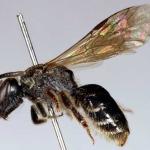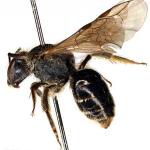A small black Lasioglossum, added to the British list by Hawkins (2011). The female is unusual in having patches of flattened plumose hairs overlying the marginal areas posteriorly on the middle tergites, rather than anteriorly as is the norm for Lasioglossum. In the male the gena is produced backwards in the form of a variably developed triangular tooth. Lasioglossum sabulosum (Warncke), sometimes synonymised with sexstrigatum, is now considered a good species.
Download a paper describing the discovery of Lasioglossum sexstrigatum in Britain.
The first British example, a female, was taken by Roger Hawkins on 5.6.2008 at a site in east Surrey. Since 2008, a few records have been made from Surrey, West Sussex, Kent and Suffolk (Else & Edwards, 2018).
It occurs in much of central and western Europe, as far north as Sweden.
This species is of too recent occurrence to be included in the Red Date Book (Shirt, 1987) or the review (Falk, 1991). The lack of earlier records suggests it may be a recent arrival.
The British site is a disused sandpit with exposures of bare, vertical sand. In Europe the bee occurs on sandy soils.
The British example was captured in early June. In Poland, females were recorded from April to October, peaking in May and early June, and males were found from late July to mid-September (Pesenko et al., 2000). However, although the authors latterly accepted the existence of sexstrigatum and sabulosum as good species they had not done so at the time the phenogram for sexstrigatum was prepared and so it probably contains data for both species.
No data available for Britain. In the Netherlands it is said to nest in the ground, often in large aggregations (Peeters et al., 1999).
No data available.
No data available for Britain. Peeters et. al. (1999) record Nomada sheppardana (Kirby), Sphecodes geoffrellus (Kirby), S. miniatus von Hagens and S. longulus von Hagens as being mentioned in the literature as cleptoparasites.
2012
Distribution text updated 2019 - Nigel Jones



